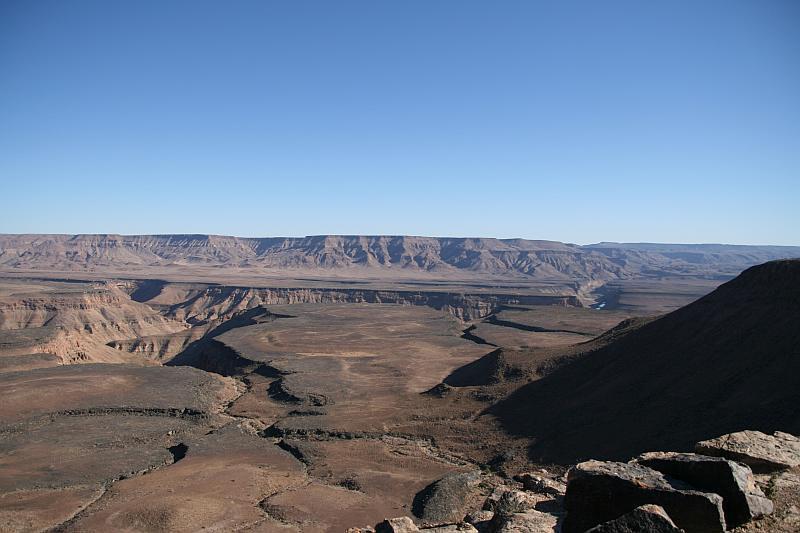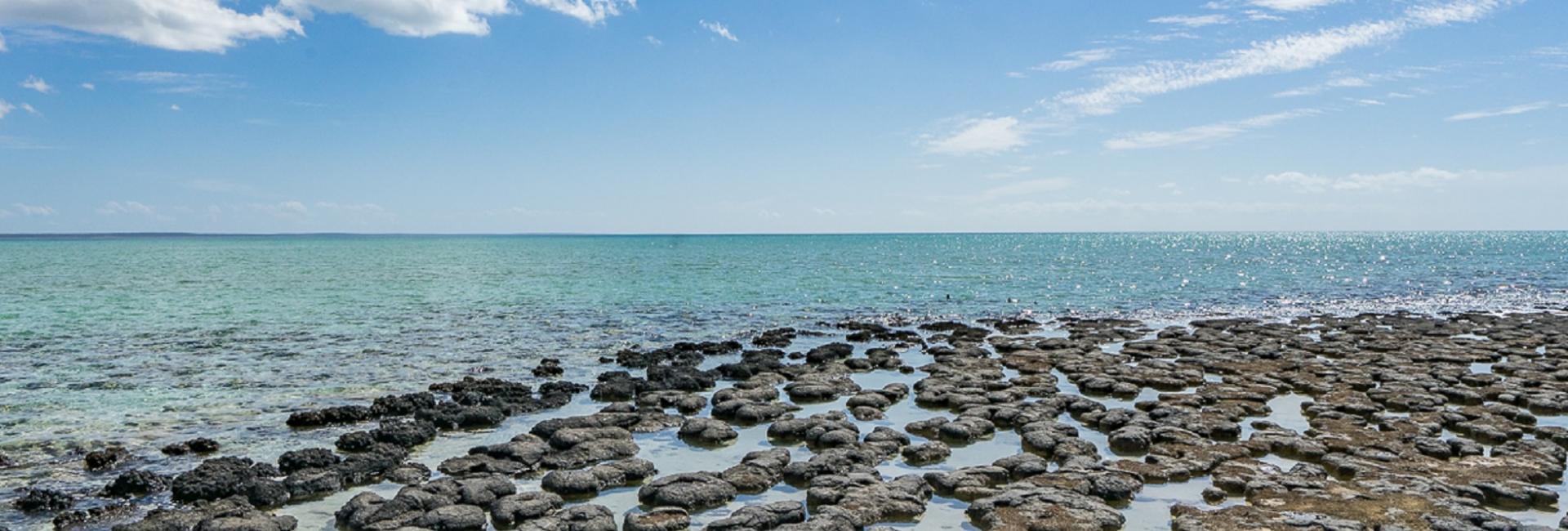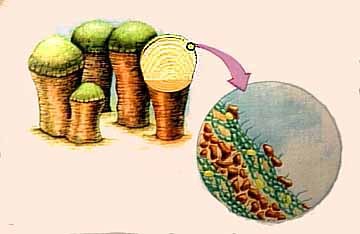
This earthcache guides you to a place at the rim of the Fish River Canyon where you can have a very deep look through the geological window of this area. But it‘s not the amazing view at the Canyon – whose formation history is already introduced by the close-by earthcache. Instead, you can look at records of ancient life on Earth.
The so-called stromatolites formed by cyanobacteria have been known as fossils since the earliest times of the Earth‘s history. The oldest stromatolites found are dated from 3.7 billion years ago (Isua Supracrustal Belt, Greenland) and from 3.64 billion years ago (Warrawoona series in Western Australia, Precambrian, Archean). Here at Hiker‘s Point, the stromatolites of a probably younger period can be discovered.
In order to understand their origin, the formation history is recapped a bit.
The rocks of the Fish River Canyon originated as layers of sediments and volcanic rocks deposited more than 1.800 million years ago in a shallow sea. After deposition they were buried to a depth exceeding 20 km by the slow accumulation of sediments. During this process they were intruded by granitic magma and transformed under high pressures and temperatures to gneiss, amphibolite and schist (ca. 1.200 million years ago). About 800 million years ago, these metamorphic rocks were invaded by doleritic magma which formed prominent dark dykes that can be seen in the canyon walls.
Erosion continued until 650 million years ago when there was a marine transgression laying down horizontal layers of sandstones and conglomerates first, then black limestones and mudstones. After the sea dried, about 550 million yeas ago, a tectonic event activated faults and a graben was formed about 350 million years ago. Originally, the gradient was shallow and most of the erosion was sideways producing a riverbed with meanders and cut-offs.
As no deformation or metamorphism followed their deposition, these rocks today are still nearly horizontal and have preserved their original sedimentary structures - thus forming a sharp contrast to the underlying massive Namaqua metamorphic rocks. At this time, the Gondwana supercontinent got closer to the South Pole and the area was affected by the Gondwana Glaciation.
With the breakup of the supercontinent about 120 million years ago and the associated elevations, the gradient of the Fish River was further increased, allowing the water to cut down within its existing bed through the Nama group into the metamorphic rocks below.

Still living stromatolite colonies on the west coast of Australia (UNESCO World Heritage).
In fact, the oldest known fossils in the world are cyanobacteria that lived at the edges of the ancient oceans as early as 3,500 million years ago. These simple bacteria increased to be the dominant life force on the planet for aeons. This period of time is known as the Proterozoic (2.500 – 530 million years ago).
Before such primitive organisms began to rely on solar energy (photosynthesis), there was almost no oxygen but carbon dioxide in Earth‘s atmosphere. But over a period of 1 billion years the activity of these small bacteria had increased the atmosphere's oxygen content to about 20% which in turn allowed for more complex life forms to evolve.
Cyanobacteria grew in colonies and carpeted the sea bed. Grains of sand remained stuck to the biofilm and eventually block sunlight. The bacteria's survival response was that of growing up through the layer of grains in order that they could continue with the process of photosynthesising, which depletes carbon dioxide in the surrounding water, initiating precipitation of calcium carbonate. Layers of calcium carbonat precipitate over the growing mat of bacterial filaments. This mineral, together with grains of sediment, is trapped within a sticky layer of mucilage that surrounds the bacterial colonies. The cyanobacteria continued to grow upwards through this sediment to form a new layer. As this process occurs over and over again, layers of sediment are created.
Since stromatolites are no skeletal fossils, but remnants of the metabolism of organisms, you will find no "imprints" of the organisms themselves. Therefore, only the precipitates of calcium carbonates and sediments that were caught here at Hiker’s Point about 550 million years ago are preserved as fossil.
Hence, the definition reads as follows:
Stromatolites are layered bio-chemical accretionary structures formed in shallow water by the trapping, binding and cementation of sedimentary grains by biofilms (microbial mats) of microorganisms, especially cyanobacteria.
 The drawing of columnar stromatolites shows internal layering and close-up of lamina structure. The surface is covered by a felt of cyanobacterial filaments that trap sediment grains that are washed across the mat surface. Abundant sediment supply produces granular laminae, low sediment supply produces layers rich in organic matter (green in drawing).
The drawing of columnar stromatolites shows internal layering and close-up of lamina structure. The surface is covered by a felt of cyanobacterial filaments that trap sediment grains that are washed across the mat surface. Abundant sediment supply produces granular laminae, low sediment supply produces layers rich in organic matter (green in drawing).
Apart from this a variety of stromatolite morphologies exist including stratiform, domal, conical and branching types, that evolved differently dependent on water depth.
Stromatolites occur widely in the fossil record of the Precambrian, but are rare today. A comparison between the recent stromatolite colonies, e.g. at Shark Bay, Australia and the fossil deposits at Hiker's Point illustrates how the landscape at the Fish River Canyon about 550 million years ago may have looked.
Especially for the early days of earth's history, from which no further fossil records exist, stromatolites point to one of the most important moments in the evolution of life. Only the mass occurrence of these ordinary bacterial colonies was ultimately responsible for the release of oxygen into the earth‘s atmosphere that finally enabled the evolution of higher life.
Have fun and take a deep breath! ;-))
Once you have sent your answers to the e-mail address of our profile, you can log your visit online. We will only contact you if something is missing or incorrect.